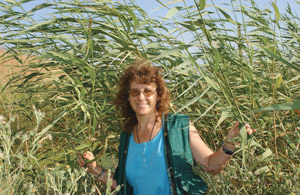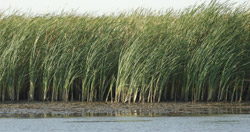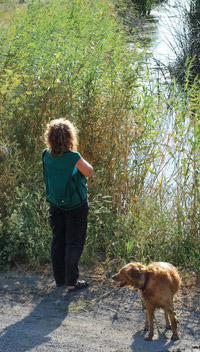Eden Again
Michelle Stevens, Ph.D. ’99, a restoration ecologist and ethnobotanist, is coordinating an international scientific effort to undo the environmental devastation Saddam Hussein wrought on the largest wetlands in the Middle East. The fate of thousands of Marsh Arabs, their 8,000-year-old culture and, possibly, the future of Iraq itself hang in the balance.
By Bryant Furlow
For millennia, Mesopotamia has been cherished for its fertile soils. Its rich marshland silts, replenished by annual floods of the Tigris and Euphrates rivers, nourished and sustained the first Western civilizations. Long before humanity came to treasure hydrocarbons above all other molecular riches, the microscopic alchemists of nitrogen, phosphorus and other greening nutrients were rightly prized. Here were the Hanging Gardens of Babylon, the genesis of stories about Eden and the Great Flood, and the Epic of Gilgamesh.
Ur and Sumer rose and fell in this lush land, and empires—Assyria, Akkadia, Chaldea—have come and gone. Abraham, progenitor of our planet’s great and troubled monotheistic religions, is believed to have been born here. And for thousands of years the persecuted have sought refuge from tyranny in this watery wilderness.
But in recent years, the stories emanating from lower Mesopotamia have been horrific tales of mechanized death and ecological catastrophe. Hushed whispers tell of bombed villages, forced relocations, poisons sprayed from the sky and a carefully planned and executed scheme to utterly destroy the marshes once and for all. In retribution for a failed Marsh Arab revolt against Saddam Hussein’s regime in 1991—a rebellion that America’s first President Bush urged on Iraqis but then failed to support—a massive network of dams and diversion canals was constructed to drain their marshland home. The Euphrates River channel was rerouted to circumvent the marshes and deny them life-sustaining nutrients and water.
 Ten thousand miles away as the marsh warbler flies, at Café Roma in downtown Davis, it becomes evident that Michelle Stevens would rather discuss almost anything other than herself: politics, poetry, war, wetlands. Ten thousand miles away as the marsh warbler flies, at Café Roma in downtown Davis, it becomes evident that Michelle Stevens would rather discuss almost anything other than herself: politics, poetry, war, wetlands.
Right now the topic is reeds. If you harbor doubts that any single species of plant could play a key role in the postwar recovery and future stability of an entire nation—particularly when that plant is an infamously tenacious, invasive species—just invest half an hour over green tea with Michelle Stevens.
Giant reeds of the genus Phragmites are invasive pests in California, she explains, but in Iraq they are the irreplaceable biochemical workhorses of the wetlands. There they sequester pollutants and transform silt-bound nutrients into the leafy detritus that forms the basis of the food web in downstream estuaries. Phragmites communis was also a literal scaffolding for Marsh Arab society: Their floating islands were woven of it, their great houses and barns built with it and their boats made of it, all in styles precisely depicted on ancient Sumerian clay tablets. Restoring reed beds, Stevens believes, will be one early and crucial step in rehabilitating the marshland ecosystem and Marsh Arab society.
The conversation meanders like the serpentine Euphrates to the intersections of ecology, culture and peace.
“Destroying the marshes was an act of genocide,” Stevens says. For her, bringing the marshes back to life is not just a practical economic imperative for the region—though it certainly is that as well. Rather, it is something approaching a moral obligation. “Restoring the marshes in some way rights that wrong and will help to heal despair.”
If Stevens hadn’t already been working on the Eden Again project to restore the Mesopotamian marshlands when the allies invaded Iraq in March, she would have marched with the peace demonstrators, she says. But learning about how a people like the Marsh Arabs could be decimated even in the absence of declared war challenged her conceptions of peace. Planning the restoration of their homeland has made her think about the role of science and ecology in the healing of traumatized peoples and lands.
“Saddam Hussein has created a ‘silent spring’ for the entire west Asian flyway,” she says. “Desertification of Eden has occurred, with all things marginally surviving or dead.”
Stevens remains deeply suspicious of the American administration’s real motives for military action, and she is certainly under no illusions that it was undertaken to stop the genocide of the Marsh Arabs. Nevertheless, Stevens sees in the war’s aftermath an unexpected opportunity to save an ecosystem and a people. And that just might help free Iraq’s economy from its reliance on one resource—oil—an economic system that spawns centralized, authoritarian governments. It may even foster more stable ties between Iraq and her neighbors.

Before disaster struck, the marshlands of lower Mesopotamia—some 8,000 square miles of wetlands surrounding the confluence of the Tigris and Euphrates rivers—were the most biologically diverse ecosystem in the Middle East. A vast oasis of connected lakes, rivulets and forests of giant reeds interspersed with stands of cottonwood, tamarisk and date palms, the marshes functioned as an ecosystem kidney. They cleansed the waters that flowed through them and into the estuaries of the Persian Gulf. Three-quarters of west Asia’s migratory birds found winter harbor amongst the reeds. Economically important gulf shrimp and fish species used the marshland estuaries as breeding habitat.
Saddam’s canals—measuring half a mile or more across and sporting names like Saddam River, Glory River and Fidelity to the Leader Canal—brought all of this to an abrupt end. They were as surely engineered for genocide as were Hitler’s camps. (Iraqi government documents captured by rebels and carried off to the United States confirm that the primary goal of the drainage scheme was to destroy the marshes and the defiant Marsh Arabs, rather than to foster agriculture upstream, as the regime publicly claimed.) For good measure, the desiccating marshes were sprayed with herbicides and pesticides, killing millions of fish and wiping out wildlife and thousands of the Marsh Arabs’ cherished water buffalo.
By the mid-1990s, only tiny pockets of Iraq’s marshes remained, totaling less than 500 square miles of viable habitat. Much of the great Central Marsh had been reduced to a pitiful archipelago of saline puddles. Maxwell’s smooth-coated otter, endemic to the marshlands, had perished, and a dozen other species—including the goliath heron, imperial eagle, Basrah reed warbler and long-fingered bat—weren’t far behind. Iraq’s freshwater fisheries and the north gulf fisheries of Iran and Kuwait had dwindled with the marshlands’ demise, and fish-killing red tides became more common as water from the polluted Euphrates was dumped directly into the gulf, unfiltered by the cleansing reed ecosystem.
The United Nations declared the situation a globally significant ecological “mega-disaster,” comparable to the loss of Amazonian rain forests.
But where there is memory, there is hope. And there is a memory of what was in the marshlands, waiting impatiently in the cortical folds of surviving Marsh Arabs who recall life before refugee camps—and also lurking in the kerneled genetic memory of the abundant plant communities that once thrived there. Seed banks await just beneath sun-baked silts.
Stevens believes that these cultural and genetic memories, coupled with sheer scientific and political determination, might just be enough to transport Mesopotamia a few decades back in time. In terms of the magnitude of damage done and the sheer acreage of that destruction, restoring Iraq’s marshlands will dwarf the effort to restore the Florida Everglades. But more than a dozen world-renowned experts in restoration ecology, soil chemistry, hydrology, wetlands botany, fish ecology and fluvial geology, all of whom volunteered to study the situation, agree with Stevens that it can be done.

Last November, Stevens was hired to manage the bold Eden Again marsh restoration program initiated by Iraqi-American engineer Azzam Alwash and geologist Suzanne Alwash. Funded by the pro-democracy Iraq Foundation, Eden Again’s immediate goals were to create an international team of scientific experts who could carefully review satellite imagery, maps, biological and soil surveys and scattered scientific studies about the marshlands. Within three months, that team was to meet for a three-day conference and determine whether restoration was possible.
Michelle Stevens was well-prepared for the job. An enthusiastic people person and eclectic intellectual—a published poet, in addition to her other accomplishments—Stevens quickly convinced over a dozen respected scientists to join Eden Again, despite the project’s inability to pay them for their time.
“It’s an incredibly prestigious team,” Stevens beams, including Ed Maltby of the Royal Holloway Institute for Environmental Research, an expert on the Mesopotamian marshlands; the University of Wisconsin’s Joy Zedler, an authority on the restoration of wetland plant communities; Curtis Richardson, director of the Duke University Wetland Center; and Thomas Crisman, director of the University of Florida’s Center for Wetlands.
She also brought her own considerable experience to the table: An environmental studies instructor at California State University, Sacramento, Stevens has worked on the Snake, Teton, Sacramento and Napa rivers, and the ethnobotany of the Putah and Cache Creek Ecoregion, and she has written monographs on hydric soils and a guide to freshwater restoration ecology. As a wetlands ecologist for the U.S. Environmental Protection Agency in the mid-1980s, Stevens was asked to restore a damaged stretch of riparian ecosystem along the Snake River in Idaho. Her bosses wanted to plant anything that would cover the soil and stem erosion.
“They had no idea of using local, native species for restoration,” Stevens recalls, shaking her head.
She rejected this mix-and-match ecology. Instead, she located an undisturbed side canyon, called Minnie Miller Springs, which had similar slope and soil characteristics, and used that spot as an “index” site—a template of native plants for the restoration site.
When the Eden Again scientists met this February at UC Irvine, they spoke with Marsh Arab refugees and spent several days going over what was known about the Mesopotamian marshlands and about other restoration projects around the world. Expert panels were formed on biology, hydrology, and soil and hydrochemistry to discuss the challenges and opportunities at hand. When all was said and done, the consensus was that restoration is indeed a realistic goal.
Satellite imagery and refugees’ reports even indicated that as much as a third of one peripheral region of the marshes—al-Haweizeh marsh, straddling the border of Iraq and Iran—remains. Borrowing a page from Stevens’ experience with Minnie Miller Springs, they designated the Haweizeh an “index site” that will be studied to determine the composition of plant communities—a template for restoration in more damaged reaches of the marshes.
The team agreed that the primary goal is to re-establish ecosystem connectivity—to have water flowing from river to marsh, and from marsh to estuary, as soon as possible. That connectivity can be achieved in many ways. Stevens and the Alwashes emphasize that returning Marsh Arabs themselves must ultimately determine the details of precisely how and where reflooding should start.
But there was a hitch. The soil chemists didn’t like what they saw where large lakes had once been. As the lakes evaporated, they left deposits of evaporites—salt pans that sudden or reckless reflooding could turn into a hypersaline slough that would wipe out seed banks, impairing the land’s ecological memory and slowing recovery efforts. “There’s this public misconception that wetlands are just water,” Stevens says. “But they are much more complex than that.”
One particular concern was the possibility that the evaporitic deposits include sulfur. In acidic soils—common in the region—wetting concentrated deposits of sulfur could create sulfuric acid. And the biologists were concerned about toxic residues in those areas that had been sprayed with pesticides. The team agreed that some contaminated areas will have to be flushed repeatedly into holding ponds separated from the restored marshes’ waters by earthen dykes. Along with the removal and closure of Saddam’s dams and canals, isolation of contaminated soils will be the “heavy lifting” with which Iraqis will probably need some outside help.
It’s too early to know what the final price tag will be for that heavy lifting. “We’re not talking about anything close to the $8 billion the United States is spending on Everglades restoration,” notes marshland authority Ed Maltby. One analyst’s estimate is that restoration in Iraq could cost as much as $100 million.
If so, it is an investment that would pay off almost immediately. Globally, wetlands provide ecosystem services like water purification, fisheries habitat and flood abatement worth an estimated $30 trillion each year. Fish caught in the marshes once constituted 60 percent of the fish consumed in Iraq. Fish and other market goods exported from the Mesopotamian marshlands—including dates and reed mats—were worth more than $620 million a year to the region, Stevens calculates.
And stemming the decline in Persian Gulf fisheries could be worth additional hundreds of millions of dollars a year to Kuwait, Iraq and Iran.
Wetlands restoration would diversify the Iraqi economy and, as the United Nations notes, stem the flow of refugees to already impoverished urban areas, reducing social strife and strain on social services. In short, wetlands restoration would be a stabilizing force in postwar Iraqi society. But despite early announcements that marshland restoration would be an American priority, no calls for funding proposals on marsh restoration have been forthcoming from the U.S. Agency for International Development, which is overseeing postwar reconstruction in Iraq. Some well-connected groups have managed to nominally fold marsh restoration into their proposals for agricultural development projects, even though they have not prepared a detailed restoration plan like Eden Again’s.
Worse yet, the American administration’s recent policy decisions to reduce protections for wetlands here in the United States seem to bode darkly for its support of those ecosystems abroad. “These recent reductions in regulatory protections are really sad,” Stevens says.
Even if the U.S. government will not support a comprehensive marsh restoration effort as part of a “Marshall Plan” for Iraq, there are other funding options. The Italian government has promised to contribute $1.3 million, and an anonymous European donor has already agreed to help, Suzanne Alwash reports. And Stevens is approaching private funding sources here in the United States.
She is heartened by the realization that local grass-roots efforts can overcome bad policy.
“Aldo Leopold’s land ethic is based on the private land owner and individuals restoring and conserving land,” Stevens says. “We’ll have to count on each individual even more to conserve wetlands and other wild lands.”
 She is optimistic that the Eden Again plan will ultimately be largely implemented by the Marsh Arabs themselves, with scientists acting as advisers. Indeed, impatient returnees have already breached a few dams to locally reflood small stretches of land near Basrah. Their efforts were rewarded within weeks: Seeds that sat dormant for a decade have germinated, and young Phragmites plants now dot the muddy banks. She is optimistic that the Eden Again plan will ultimately be largely implemented by the Marsh Arabs themselves, with scientists acting as advisers. Indeed, impatient returnees have already breached a few dams to locally reflood small stretches of land near Basrah. Their efforts were rewarded within weeks: Seeds that sat dormant for a decade have germinated, and young Phragmites plants now dot the muddy banks.
Stevens’ ethnobotanist appreciation for the connections between indigenous cultures and the land is personal. Her father and his mother are Nez Pierce members of the Colville Confederated Tribes in Washington State. “I’m a weird scientist,” she laughs, “a scientist and a spiritual person. The only thing that keeps me sane is poetry.”
Many North American restoration ecologists speak of “pristine” habitats, as though they are devoid of human influence. It’s a conceptual artifact of our own continent’s past genocides, which left wilderness landscapes artificially unpeopled. Stevens speaks instead of indigenous cultures and their traditional ecological knowledge as central components of ecosystem management.
“The value of the marshes and the living nature of the marshlands to the Iraqi people are readily discernible,” Stevens says. “The relationship between wetlands and the indigenous people is integral and synergistic. Saddam Hussein knew that if he poisoned the marshes, he would destroy the people. Conversely, to restore the marshes will also help people heal—not only in Iraq but here in California and throughout the world.”
Bryant Furlow is a freelance science writer and a regular contributor to New Scientist magazine. He plans to write a book about efforts to restore Iraq’s marshlands and the marshes’ role in the postwar economic recovery of the region. Photography by Debbie Aldridge/UC Davis Public Communications.
|

